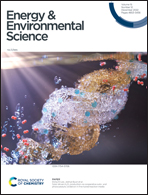An integrated self-healing anode assembled via dynamic encapsulation of liquid metal with a 3D Ti3C2Tx network for enhanced lithium storage†
Abstract
Given their high theoretical capacity, alloy-based anodes are promising candidates for lithium-ion batteries (LIBs) to meet the stringent demand of today's portable electronic devices and electric vehicles. However, the intrinsic limitations of volume expansion and irreversible pulverization lead to the sharp capacity decay and short cyclic life of the LIBs. Liquid metal (LM), possessing an inborn large capacity and inheriting deformability as liquids, can fundamentally avoid a large volume change during the electrochemical reactions. Herein, we report a facile strategy to self-assemble 2D Ti3C2Tx MXene into a 3D architecture, and simultaneously in situ encapsulate eutectic gallium indium (EGaIn) within the individual “MXene cell”. Inside the cell, the extraction of lithium ions from the ternary solid alloy brings LM back to the binary liquid state, enabling a self-healing process of the cracked or pulverized structure; outside the cell, the elastic network of the Ti3C2Tx skeleton buffers the volume expansion of the lithiated EGaIn. The as-prepared LM-Ti3C2Tx anode exhibited a superior rate capability (489 mA h g−1 at 5 A g−1) and excellent cycling stability (409.8 mA h g−1 after 4500 cycles at 5 A g−1, 90.8% capacity retention). Furthermore, we demonstrated that the reversible liquid–solid phase transformation and the formation of a distinct indium core/gallium shell structure is responsible for its self-healing properties. This work shows great potential for solving the inherent volume expansion problems of alloy-based anode materials.



 Please wait while we load your content...
Please wait while we load your content...